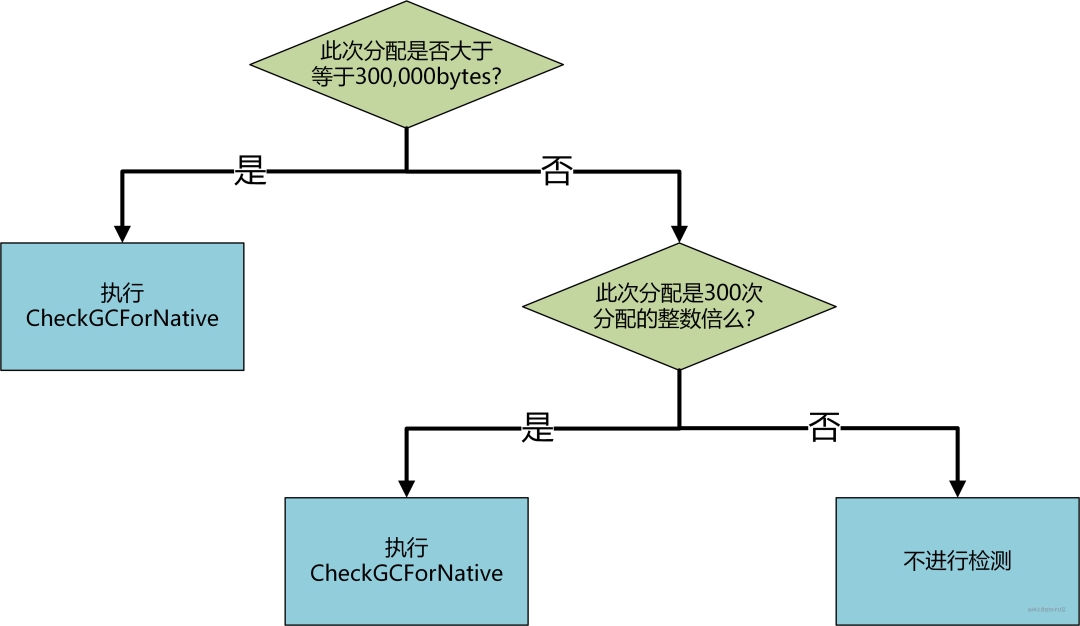ART 虚拟机 | 如何让 GC 同步回收 native 内存
本文分析基于Android R(11)
前言
GC用于Java堆内存的回收,这是人尽皆知的事实。然而现在有些Java类被设计成牵线木偶,Java对象只存储一些“线”,其真实的内存消耗全都放到了native内存中。譬如Bitmap。对它们而言,如何自动回收操纵的native内存成为一个亟须解决的问题。
想要自动回收,必须依赖GC机制。但仅仅依靠现有的GC机制还不够。我们还需要考虑以下两点:
- 如何在native内存增长过多的时候 自动 触发GC
- 如何在GC回收Java对象时 同步回收 native资源
Android从N开始引入了NativeAllocationRegistry类。早期的版本可以保证在GC回收Java对象时同步回收native资源(上述第2点),其内部用到的正是上一篇博客介绍过的Cleaner机制。
利用早期版本的NativeAllocationRegistry,native资源虽然可以回收,但仍然有些缺陷。譬如被设计成牵线木偶的Java类所占空间很小,但其间接引用的native资源占用很大。因此就会导致Java堆的增长很慢,而native堆的增长很快。
在某些场景下,Java堆的增长还没有达到下一次GC触发的水位,而native堆中的垃圾已经堆积成山。由程序主动调用System.gc()当然可以缓解这个问题,但开发者如何控制这个频率?频繁的话就会降低运行性能,稀疏的话就会导致native垃圾无法及时释放。
因此新版本的NativeAllocationRegistry连同GC一起做了调整,使得进程在native内存增长过多的时候可以自动触发GC,也即上述的第1点。相当于以前的GC触发只考虑Java堆的使用大小,现在连同native堆一起考虑进去了。
native垃圾堆积成山的问题会导致一些严重的问题,譬如最近国内很多32位APK上碰到过的native内存OOM问题,其中字节跳动专门发过博客介绍他们的解决方案。在链接的博客里,字节跳动团队提供了应用层的解决方案,由应用层来主动释放native资源。
但这个问题的根本解决还得依赖底层设计的修改。看完字节跳动的博客后,我专门联系过Android团队,建议他们在CameraMetadataNative类中使用NativeAllocationRegistry。他们很快接受了这个提议,并提供了新的实现。相信字节跳动遇到的这个问题在S上将不会存在。
目录
1 . 如何在native内存增长过多时自动触发GC
当Java类被设计成牵线木偶时,其native内存的分配通常有两种方式。一种是malloc(new的内部通常也是调用malloc)分配堆内存,另一种是mmap分配匿名页。二者最大的区别是malloc通常用于小内存分配,而mmap通常用于大内存分配。
当我们使用NativeAllocationRegistry为该Java对象自动释放native内存时,首先需要调用registerNativeAllocation,一方面告知GC本次native分配的资源大小,另一方面检测是否达到GC的触发条件。根据内存分配方式的不同,处理方式也不太一样。
libcore/luni/src/main/java/libcore/util/NativeAllocationRegistry.java
290 // Inform the garbage collector of the allocation. We do this differently for
291 // malloc-based allocations.
292 private static void registerNativeAllocation(long size) {
293 VMRuntime runtime = VMRuntime.getRuntime();
294 if ((size & IS_MALLOCED) != 0) { <==================如果native内存是通过malloc方式分配的,则走这个if分支
295 final long notifyImmediateThreshold = 300000;
296 if (size >= notifyImmediateThreshold) { <=========如果native内存大于等于300000bytes(~300KB),则走这个分支
297 runtime.notifyNativeAllocationsInternal();
298 } else { <==================如果native内存小于300000bytes,则走这个分支
299 runtime.notifyNativeAllocation();
300 }
301 } else {
302 runtime.registerNativeAllocation(size);
303 }
304 }1.1 Malloc内存

- 此次分配是否大于等于300,000bytes。大于的话则走VIP通道直接执行
CheckGCForNative函数。该函数内部会统计native内存分配的总量,判断其是否达到GC触发的阈值。如果达到的话则触发一次GC。 - 此次分配是否是300次分配的整数倍。这个判定条件用于限定
CheckGCForNative的执行次数,每300次malloc才去执行一次检测。
接下来看看CheckGCForNative函数内部的逻辑。
首先计算当前native内存的总大小,然后计算当前内存大小和阈值之间的比值,如果比值≥1,则请求一次新的GC。
art/runtime/gc/heap.cc
3927 inline void Heap::CheckGCForNative(Thread* self) {
3928 bool is_gc_concurrent = IsGcConcurrent();
3929 size_t current_native_bytes = GetNativeBytes(); <================获取native内存的总大小
3930 float gc_urgency = NativeMemoryOverTarget(current_native_bytes, is_gc_concurrent); <============计算当前内存大小和阈值之间的比值,大于等于1则表明需要一次新的GC
3931 if (UNLIKELY(gc_urgency >= 1.0)) {
3932 if (is_gc_concurrent) {
3933 RequestConcurrentGC(self, kGcCauseForNativeAlloc, /*force_full=*/true); <=================请求一次新的GC
3934 if (gc_urgency > kStopForNativeFactor
3935 && current_native_bytes > stop_for_native_allocs_) {
3936 // We're in danger of running out of memory due to rampant native allocation.
3937 if (VLOG_IS_ON(heap) || VLOG_IS_ON(startup)) {
3938 LOG(INFO) << "Stopping for native allocation, urgency: " << gc_urgency;
3939 }
3940 WaitForGcToComplete(kGcCauseForNativeAlloc, self);
3941 }
3942 } else {
3943 CollectGarbageInternal(NonStickyGcType(), kGcCauseForNativeAlloc, false);
3944 }
3945 }
3946 }获取当前native内存的总大小需要调用GetNativeBytes函数。其内部统计也分为两部分,一部分是通过mallinfo获取的当前malloc的总大小。
由于系统有专门的API获取这个信息,所以在NativeAllocationRegistry.registerNativeAllocation的时候不需要专门去存储单次malloc的大小。另一部分是native_bytes_registered_字段记录的所有注册过的mmap大小。二者相加,基本上反映了当前进程native内存的整体消耗。
art/runtime/gc/heap.cc
2533 size_t Heap::GetNativeBytes() {
2534 size_t malloc_bytes;
2535 #if defined(__BIONIC__) || defined(__GLIBC__)
2536 IF_GLIBC(size_t mmapped_bytes;)
2537 struct mallinfo mi = mallinfo();
2538 // In spite of the documentation, the jemalloc version of this call seems to do what we want,
2539 // and it is thread-safe.
2540 if (sizeof(size_t) > sizeof(mi.uordblks) && sizeof(size_t) > sizeof(mi.hblkhd)) {
2541 // Shouldn't happen, but glibc declares uordblks as int.
2542 // Avoiding sign extension gets us correct behavior for another 2 GB.
2543 malloc_bytes = (unsigned int)mi.uordblks;
2544 IF_GLIBC(mmapped_bytes = (unsigned int)mi.hblkhd;)
2545 } else {
2546 malloc_bytes = mi.uordblks;
2547 IF_GLIBC(mmapped_bytes = mi.hblkhd;)
2548 }
2549 // From the spec, it appeared mmapped_bytes <= malloc_bytes. Reality was sometimes
2550 // dramatically different. (b/119580449 was an early bug.) If so, we try to fudge it.
2551 // However, malloc implementations seem to interpret hblkhd differently, namely as
2552 // mapped blocks backing the entire heap (e.g. jemalloc) vs. large objects directly
2553 // allocated via mmap (e.g. glibc). Thus we now only do this for glibc, where it
2554 // previously helped, and which appears to use a reading of the spec compatible
2555 // with our adjustment.
2556 #if defined(__GLIBC__)
2557 if (mmapped_bytes > malloc_bytes) {
2558 malloc_bytes = mmapped_bytes;
2559 }
2560 #endif // GLIBC
2561 #else // Neither Bionic nor Glibc
2562 // We should hit this case only in contexts in which GC triggering is not critical. Effectively
2563 // disable GC triggering based on malloc().
2564 malloc_bytes = 1000;
2565 #endif
2566 return malloc_bytes + native_bytes_registered_.load(std::memory_order_relaxed);
2567 // An alternative would be to get RSS from /proc/self/statm. Empirically, that's no
2568 // more expensive, and it would allow us to count memory allocated by means other than malloc.
2569 // However it would change as pages are unmapped and remapped due to memory pressure, among
2570 // other things. It seems risky to trigger GCs as a result of such changes.
2571 }得到当前进程native内存的总大小之后,便需要抉择是否需要一次新的GC。
决策的过程如下,源码下面是详细解释。
art/runtime/gc/heap.cc
3897 // Return the ratio of the weighted native + java allocated bytes to its target value.
3898 // A return value > 1.0 means we should collect. Significantly larger values mean we're falling
3899 // behind.
3900 inline float Heap::NativeMemoryOverTarget(size_t current_native_bytes, bool is_gc_concurrent) {
3901 // Collection check for native allocation. Does not enforce Java heap bounds.
3902 // With adj_start_bytes defined below, effectively checks
3903 // <java bytes allocd> + c1*<old native allocd> + c2*<new native allocd) >= adj_start_bytes,
3904 // where c3 > 1, and currently c1 and c2 are 1 divided by the values defined above.
3905 size_t old_native_bytes = old_native_bytes_allocated_.load(std::memory_order_relaxed);
3906 if (old_native_bytes > current_native_bytes) {
3907 // Net decrease; skip the check, but update old value.
3908 // It's OK to lose an update if two stores race.
3909 old_native_bytes_allocated_.store(current_native_bytes, std::memory_order_relaxed);
3910 return 0.0;
3911 } else {
3912 size_t new_native_bytes = UnsignedDifference(current_native_bytes, old_native_bytes); <=======(1)
3913 size_t weighted_native_bytes = new_native_bytes / kNewNativeDiscountFactor <=======(2)
3914 + old_native_bytes / kOldNativeDiscountFactor;
3915 size_t add_bytes_allowed = static_cast<size_t>( <=======(3)
3916 NativeAllocationGcWatermark() * HeapGrowthMultiplier());
3917 size_t java_gc_start_bytes = is_gc_concurrent <=======(4)
3918 ? concurrent_start_bytes_
3919 : target_footprint_.load(std::memory_order_relaxed);
3920 size_t adj_start_bytes = UnsignedSum(java_gc_start_bytes, <=======(5)
3921 add_bytes_allowed / kNewNativeDiscountFactor);
3922 return static_cast<float>(GetBytesAllocated() + weighted_native_bytes) <=======(6)
3923 / static_cast<float>(adj_start_bytes);
3924 }
3925 }首先将本次native内存总大小和上一次GC完成后的native内存总大小进行比较。如果小于上次的总大小,则表明native内存的使用水平降低了,因此完全没有必要进行一次新的GC。
但如果这次native内存使用增长的话,则需要进一步计算当前值和阈值之间的比例关系,大于等于1的话就需要进行GC。下面详细介绍源码中的(1)~(6)。
(1)计算本次native内存和上次之间的差值,这个差值反映了native内存中新增长部分的大小。
(2)给不同部分的native内存以不同的权重,新增长部分除以2,旧的部分除以65536。之所以给旧的部分权重如此之低,是因为native堆本身是没有上限的。这套机制的初衷并不是限制native堆的大小,而只是防止两次GC间native内存垃圾积累过多。
(3)所谓的阈值并不是为native内存单独设立的,而是为(Java堆大小+native内存大小)整体设立的。add_bytes_allowed表示在原有Java堆阈值的基础上,还可以允许的native内存大小。NativeAllocationGcWatermark根据Java堆阈值计算出允许的native内存大小,Java堆阈值越大,允许的值也越大。HeapGrowthMultipiler对于前台应用是2,表明前台应用的内存管控更松,GC触发频率更低。
(4)同等条件下,同步GC的触发水位要低于非同步GC,原因是同步GC在垃圾回收时也会有新的对象分配,因此加上这些新分配的对象最好也不要超过阈值。
(5)将Java堆阈值和允许的native内存相加,作为新的阈值。
(6)将Java堆已分配的大小和调整权重后的native内存大小相加,并将相加后的结果除以阈值,得到一个比值来判定是否需要GC。
通过如下代码可知,当比值≥1时,将请求一次新的GC。
art/runtime/gc/heap.cc
3931 if (UNLIKELY(gc_urgency >= 1.0)) {
3932 if (is_gc_concurrent) {
3933 RequestConcurrentGC(self, kGcCauseForNativeAlloc, /*force_full=*/true); <=================请求一次新的GC1.2 MMap内存
mmap的处理方式和malloc基本相当,大于300,000 bytes或mmap三百次都执行CheckGCForNative。
唯一的区别在于mmap需要将每一次的大小都计入native_bytes_registered中,因为mallinfo中并不会记录这个信息(针对bionic库而言)。
art/runtime/gc/heap.cc
3957 void Heap::RegisterNativeAllocation(JNIEnv* env, size_t bytes) {
3958 // Cautiously check for a wrapped negative bytes argument.
3959 DCHECK(sizeof(size_t) < 8 || bytes < (std::numeric_limits<size_t>::max() / 2));
3960 native_bytes_registered_.fetch_add(bytes, std::memory_order_relaxed);
3961 uint32_t objects_notified =
3962 native_objects_notified_.fetch_add(1, std::memory_order_relaxed);
3963 if (objects_notified % kNotifyNativeInterval == kNotifyNativeInterval - 1
3964 || bytes > kCheckImmediatelyThreshold) {
3965 CheckGCForNative(ThreadForEnv(env));
3966 }
3967 }2 . 如何在Java对象回收时触发native内存回收
NativeAllocationRegistry中主要依靠Cleaner机制完成了这个过程。关于Cleaner的细节,可以参考我的上篇博客。
3 . 实际案例
Bitmap类就是通过NativeAllocationRegistry来实现native资源自动释放的。以下是Bitmap构造方法的一部分。
frameworks/base/graphics/java/android/graphics/Bitmap.java
155 mNativePtr = nativeBitmap; <=========================== 通过指针值间接持有native资源
156
157 final int allocationByteCount = getAllocationByteCount(); <==== 获取native资源的大小,如果是mmap方式,这个大小最终会计入native_bytes_registered中
158 NativeAllocationRegistry registry;
159 if (fromMalloc) {
160 registry = NativeAllocationRegistry.createMalloced( <==== 根据native资源分配方式的不同,构造不同的NativeAllocationRegistry对象,nativeGetNativeFinalizer()返回的是native资源释放函数的函数指针
161 Bitmap.class.getClassLoader(), nativeGetNativeFinalizer(), allocationByteCount);
162 } else {
163 registry = NativeAllocationRegistry.createNonmalloced(
164 Bitmap.class.getClassLoader(), nativeGetNativeFinalizer(), allocationByteCount);
165 }
166 registry.registerNativeAllocation(this, nativeBitmap); <===== 检测是否需要GC通过上述案例可知,当我们使用NativeAllocationRegistry来为Java类自动释放native内存资源时,首先需要创建NativeAllocationRegistry对象,接着调用registerNativeAllocation方法。只此两步,便可实现native资源的自动释放。
既然需要两步,那为什么registerNativeAllocation不放进NativeAllocationRegistry的构造方法,这样一步岂不是更好?
原因是registerNativeAllocation独立出来,便可以在native资源真正申请后再去告知GC,灵活性更高。此外,NativeAllocationRegistry中还有一个registerNativeFree方法与之对应,可以让应用层在自己提前释放native资源后告知GC。
